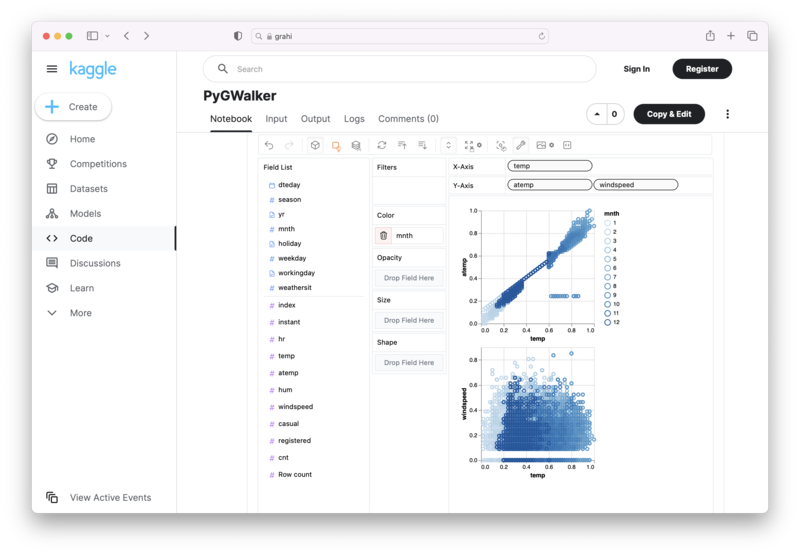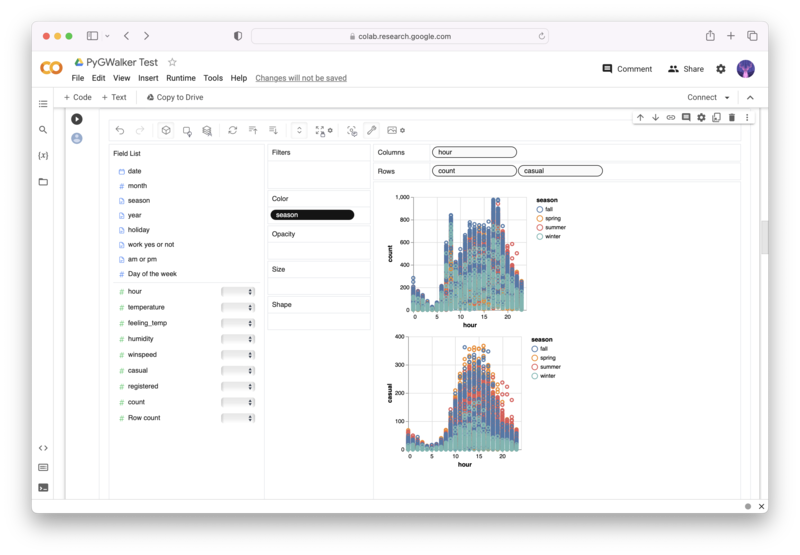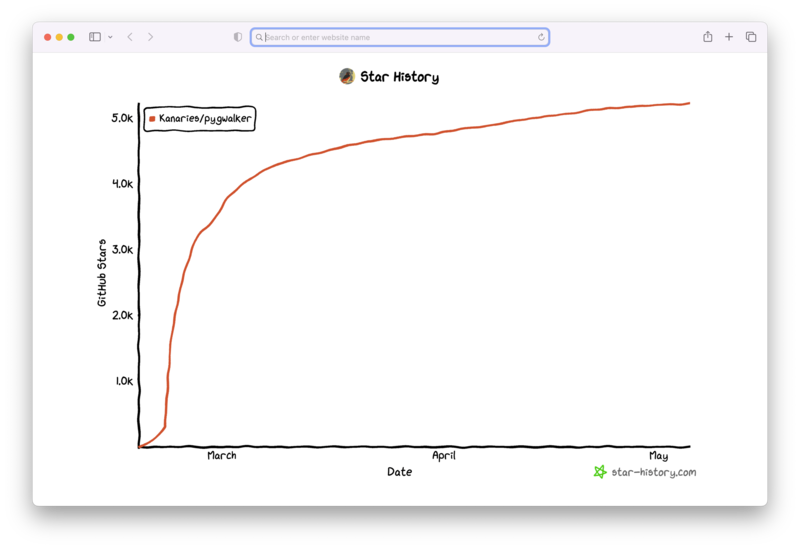NumPy vs Pandas: Unleashing the Power of Python in Data Analysis
Published on
Python has become a go-to language for data science, not because of its own capabilities, but due to the power of its libraries that specialize in numerical and data processing. Two of the most prominent ones are NumPy and Pandas. These libraries are not rivals, but rather companions, each with its own strengths and use cases. Let's dive into the world of Python data analysis with NumPy and Pandas, and understand how to choose the right tool for your data tasks.
Want to quickly create Data Visualizations in Python?
PyGWalker is an Open Source Python Project that can help speed up the data analysis and visualization workflow directly within a Jupyter Notebook-based environments.
PyGWalker (opens in a new tab) turns your Pandas Dataframe (or Polars Dataframe) into a visual UI where you can drag and drop variables to create graphs with ease. Simply use the following code:
pip install pygwalker
import pygwalker as pyg
gwalker = pyg.walk(df)You can run PyGWalker right now with these online notebooks:
And, don't forget to give us a ⭐️ on GitHub!
Understanding NumPy
NumPy, short for Numerical Python, was released as an open-source project in 2005 with the aim of bringing scientific computing to Python. It was based on two earlier packages, Numeric and Numarray, and its strength lies in its ability to work with multi-dimensional array objects.
import numpy as np
# Creating a 2D array in NumPy
array_2d = np.array([[1, 2, 3], [4, 5, 6], [7, 8, 9]])
print(array_2d)NumPy provides tools for sorting, searching, filtering, and applying linear algebra and Fourier transforms. It leverages Basic Linear Algebra Subprogram (BLAS) and Linear Algebra PACKage (LAPACK) to supercharge its linear algebra capabilities. This makes it a powerful tool for handling large amounts of data much faster than Python's built-in functions.
The Power of Pandas
While NumPy excels in numerical analysis and simulations, when it comes to data analysis and manipulation, working with a wide range of data sources, that's where Pandas shines.
Pandas was developed in 2008 by Wes McKinney, who was looking for a powerful and flexible tool for quantitative analysis on financial data. Named after the three-dimensional PANel DAta it works with, Pandas was made open-source the following year.
import pandas as pd
# Creating a DataFrame in Pandas
data = {'Name': ['John', 'Anna', 'Peter'],
'Age': [28, 24, 33]}
df = pd.DataFrame(data)
print(df)Pandas simplifies the process of working with data by providing methods for loading, reshaping, pivoting, merging, and joining data. It also provides tools for handling missing data. It excels at working with tabular data, making it a preferred choice for data analysis tasks.
NumPy vs Pandas: Diving Deeper
Explain Numpy
NumPy's core functionality revolves around its n-dimensional array objects. These arrays are homogeneous, meaning all elements are of the same type, usually integers or floating-point numbers. This makes NumPy particularly useful for tasks that require mathematical operations on large datasets.
For instance, if you're working on a project that involves simulations or numerical analysis, NumPy's efficient multi-dimensional arrays and mathematical functions can be extremely useful. It's also a great choice for projects that require integration with C/C++ or Fortran code, as NumPy provides seamless and speedy interoperability.
Exploring the Strengths of Pandas
Pandas, on the other hand, is designed for working with complex data structures and manipulating data. It provides two key data structures: Series and DataFrame. A Series is a one-dimensional array-like object that can hold any data type, while a DataFrame is a two-dimensional labeled data structure with columns potentially of different types.
Pandas shines when it comes to data munging and preparation. It provides extensive capabilities to reshape, slice, dice, and aggregate data. It's also a great tool for handling time series data. If your project involves data analysis, data cleaning, or data visualization, Pandas is likely the right tool for the job.
NumPy vs Pandas: Performance Considerations
While Pandas does bring some overhead due to its additional features, it also implements a number of functions optimized with C and Cython. This means that for very large datasets, some operations in Pandas can actually be faster than their NumPy equivalents.
However, for smaller datasets or tasks that primarily involve numerical computations, NumPy might be the more efficient choice. It's also worth noting that since Pandas is built on top of NumPy, you can often use the two libraries together, leveraging the strengths of each as needed.
NumPy vs Pandas: Choosing the Right Tool
Pandas is built on top of NumPy, which means most of NumPy's methods are available through Pandas. However, this also brings some overhead in terms of performance and learning curve. Pandas' capabilities come with a cost of complexity. Yet, it implements a number of functions optimized with C and Cython, which can be faster than the NumPy equivalent for very large datasets.
The general consensus seems to be to start with NumPy and look for the features you're most likely to need. If that search leads you to Pandas, then there's your answer. It's not about choosing one over the other, but rather about picking the right tool for the task at hand.
Frequently Asked Questions
1. Is Pandas better than NumPy?
It's not about one being better than the other. Both Pandas and NumPy have their own strengths. NumPy is more efficient for numerical operations on large datasets, while Pandas is more suitable for data manipulation and analysis tasks.
2. Can I use NumPy and Pandas together?
Absolutely! In fact, since Pandas is built on top of NumPy, you're already using NumPy when you're using Pandas. You can certainly use both libraries in the same project, leveraging the strengths of each as needed.
3. Should I learn NumPy or Pandas first?
It's generally recommended to start with NumPy, as it provides the foundational data structures and operations that Pandas builds upon. Once you're comfortable with NumPy, you can move on to learning Pandas.


